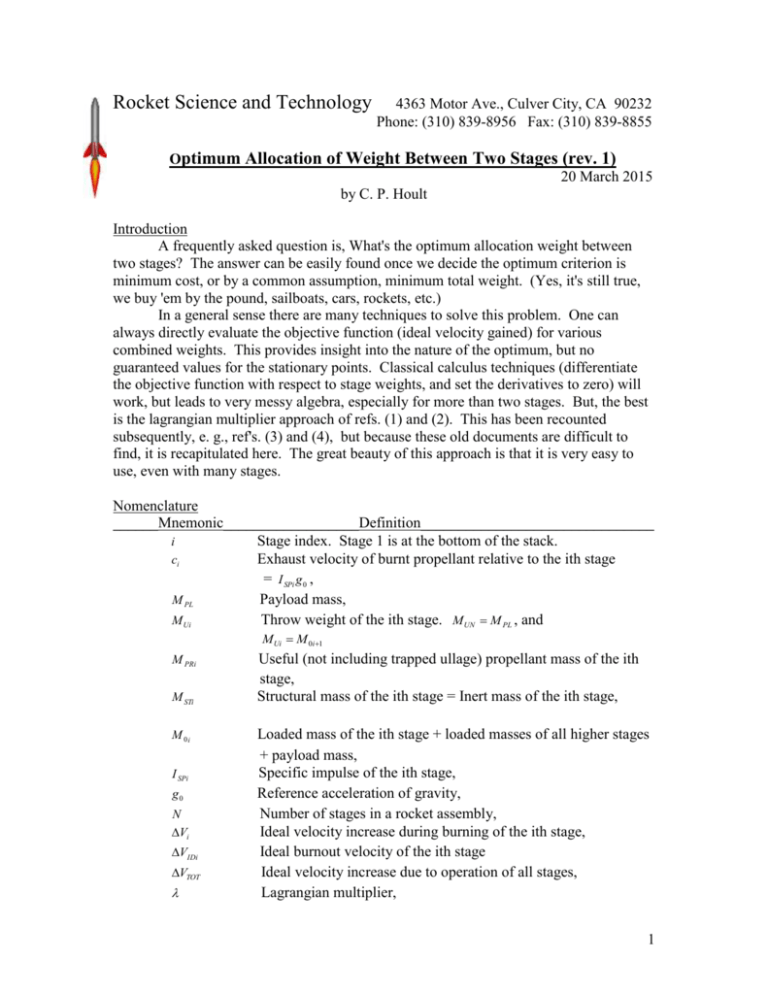Two StageWeights - Rocket Science and Technology
advertisement

Rocket Science and Technology 4363 Motor Ave., Culver City, CA 90232 Phone: (310) 839-8956 Fax: (310) 839-8855 Optimum Allocation of Weight Between Two Stages (rev. 1) 20 March 2015 by C. P. Hoult Introduction A frequently asked question is, What's the optimum allocation weight between two stages? The answer can be easily found once we decide the optimum criterion is minimum cost, or by a common assumption, minimum total weight. (Yes, it's still true, we buy 'em by the pound, sailboats, cars, rockets, etc.) In a general sense there are many techniques to solve this problem. One can always directly evaluate the objective function (ideal velocity gained) for various combined weights. This provides insight into the nature of the optimum, but no guaranteed values for the stationary points. Classical calculus techniques (differentiate the objective function with respect to stage weights, and set the derivatives to zero) will work, but leads to very messy algebra, especially for more than two stages. But, the best is the lagrangian multiplier approach of refs. (1) and (2). This has been recounted subsequently, e. g., ref's. (3) and (4), but because these old documents are difficult to find, it is recapitulated here. The great beauty of this approach is that it is very easy to use, even with many stages. Nomenclature ______Mnemonic__________________Definition_______________________________ Stage index. Stage 1 is at the bottom of the stack. i Exhaust velocity of burnt propellant relative to the ith stage ci = I SPi g 0 , Payload mass, M PL Throw weight of the ith stage. M UN M PL , and M Ui M Ui M 0i1 M PRi M STi M 0i I SPi g0 N Vi VIDi VTOT Useful (not including trapped ullage) propellant mass of the ith stage, Structural mass of the ith stage = Inert mass of the ith stage, Loaded mass of the ith stage + loaded masses of all higher stages + payload mass, Specific impulse of the ith stage, Reference acceleration of gravity, Number of stages in a rocket assembly, Ideal velocity increase during burning of the ith stage, Ideal burnout velocity of the ith stage Ideal velocity increase due to operation of all stages, Lagrangian multiplier, 1 ______Mnemonic__________________Definition_______________________________ M PRi , M Oi i Propellant ratio = i Payload ratio = i Mass ratio = initial mass / burnout mass of the ith stage, i M Oi1 , M Oi M 0i , M 0i M PRi Structural efficiency of the ith stage = M STi / M STi M PRi Glossary See Fig. 1 for a notional description of a three stage rocket. Ideal velocity is the velocity increase that would have been obtained if there were no drag or gravity losses, Initial mass of the ith stage is the mass, with propellant, of the ith stage + the total mass of all stages above the ith stage, with propellant, + payload mass, Burnout mass of the ith stage is the structural mass of the ith stage + the total mass of all stages above the ith stage, with propellant, + payload mass Reference acceleration of gravity is that official value of g used to convert measured weights to masses, Structural mass of a stage is all non-consumable mass = inert mass of the stage, Useful propellant mass of a stage is all the mass consumed and expelled from the stage Tsiolkovskii's Law The first modern model for the ideal velocity was due to K. E. Tsiolkovskii, a high school physics teacher living in a remote farming district in Czarist Russia. His result for a single stage rocket was V c log I SP g 0 log( M ST M PR ). M ST (1) Tsiolkovskii also showed that for a multistage rocket the total ideal velocity is just the sum of the individual stage ideal velocities: N N 1 1 VTOT Vi I SPi g 0 log( i ) . (2) Finally, if all stages have the same mass ratio and specific impulse, VTOT NI SP g 0 log By using multiple stages very high total velocities can be attained. 2 Optimum Stage Masses There are two ways to specify this problem: First, for a fixed total mass, number of stages and payload mass find that stage mass allocation that maximizes the ideal velocity increase. Second, for a fixed ideal velocity increase, number of stages and payload mass find that stage mass allocation that minimizes the total mass at liftoff. Since these two formulations are essentially the same, we choose arbitrarily to maximize the total ideal velocity Next, it is easy to show that i (1 i )(1 i ) , and i (3) 1 1 , 1 i i (1 i ) i (4) The total payload ratio is M UN M U 1 M U 2 M UN M 02 M 03 M PL ... ... , or M 01 M 01 M 02 M 0 N M 01 M 02 M 0 N TOT M PL , M 01 (5) and it's easy to show that M PL 1 2 ... N . M 01 (6) Next, the total propellant ratio is: TOT M PRi M 01 , and M PRi M PRi M 0i M ... 02 i1 2 ... i 1 M 01 M 0i M 0i 1 M 01 Then, TOT 1 21 .... N1 2 ... N 1 . (7) In the same way, the total structural efficiency is TOT M M M STi STi PRi 1 1 TOT M M STi . 0 3 M STi But, STi 1 STi M PRi , and M STi i i1 2 .... i 1 . M0 1 i (8) Finally, TOT 1 1 (1 1 ) 2 (1 2 )1 ...... N (1 N )1 2 .... N 1 . 1 TOT (9) Our optimization problem can be formulated in three equivalent ways: (a) Maximize the payload mass for given VTOT and total liftoff mass, or (b) Minimize the liftoff mass for given VTOT and payload mass, or (c) Maximize VTOT for a given payload ratio. So, this implies that we need to determine the payload ratios such that N VIDi g 0 I SPi log( i i (1 i )) (10) iN1i TOT . (11) i 1 subject to It will prove convenient to rewrite the side condition, eq. (11), as N Log ( ) log( i TOT )0 (12) i 1 Next, define an augmented function F as N F ( i ) VIDi log( i ) log(TOT ), i 1 (13) where (ref. (5)) is a lagrangian multiplier. The necessary condition for VIDi to be maximized while satisfying eq. (12) is F 0, i 1,2,..., N . i (14) Substituting eq's. (10) and (13) into eq. (14) gives g 0 I SPi 1i 0. i i (1 i ) i (15) 4 Solving for the i leads to i i ( g 0 I SPi )(1 i ) . (16) The lagrangian multiplier can be found by substituting eq. (16) into eq. (12): N log ( g I i 1 0 SPi i log(TOT ) . )(1 i ) (17) Now, the important fact is that eq.(17) has only one unknown, . The optimal payload ratio, and the maximum VTOT are found by solving eq. (17) for , and substituting the result into eq's. (16) to find the payload ratios. Finally, the ideal velocity can be found from eq.(10). Note that eq.(17) has, in general, multiple solutions. It is necessary to find all the solutions and determine the one with the greatest VTOT by substitution. Common Specific Impulse In general, eq. (17) is an algebraic equation of order N that cannot be solved analytically. Its solution is straightforward if all stages share a common specific impulse. Then, g 0 I SP (1 1 )(1 2 )....(1 N ) TOT 1 2 .... N 1/ N . Next, substitute this into eq. (16) to give i (1 1 )(1 2 )....( 1 N ) i TOT 1i 1 2 .... N (1/ N ) . (18) Substitution of these results back into eq. (10) yields the maximum ideal velocity: VID max N (1 / N ) ( 1 ( 1 )....( 1 ) 1 2 N . g 0 I SP log 1 2 .... N 1 TOT 1 2 .... N On the other hand, if VID is specified TOT max where U exp( U / N ) ( .... ) (1/ N ) (1 1 )(1 2 )....( 1 N ) 1 VID g 0 I SP 2 N (19) N , (20) 5 For a two stage rocket, these simplify even more to VID max 2 log 1 2 TOT (1 1 )(1 2 ) , and TOT max exp( U / N ) 1 2 (1 1 )(1 2 ) . (21) (22) The individual stage payload ratios are found from eq. (18): i i 1i (1 1 )(1 2 ) TOT 1 2 1/ 2 . (21) Assuming I SP ( I SP1 I SP 2 ) / 2 , Eq. (22) has been coded as OPT2STGE.xls) First Stage Third Stage Second Stage Payload References 1. Vertregt, M., "Calculation of Step-Rockets", J. Brit. Interplanetary Soc., Vol 14 (1955), pp 20-25. 2. Vertregt, M, " A Method for Calculating the Mass Ratios of Step-Rockets", J. Brit. Interplanetary Soc., Vol 15 (1956), pp 95-97. 3. Coleman, J. J., "Optimum Stage-Weight Distribution of Multistage Rockets", Space Technology Laboratories, Inc., Report STL/TN-60-0000-9036, 1960. 4. Barrere, M., Jaumotte, A., de Veubeke, B., and Vandenkerchkove, "Rocket Propulsion, pp. 731-746, Elsevier Publishing Company, Princeton, 1960 5. Hildebrand, F. B., "Methods of Applied Mathematics", Prentiss-Hall, Inc., Englewood Cliffs, N.J., 1956. 6




